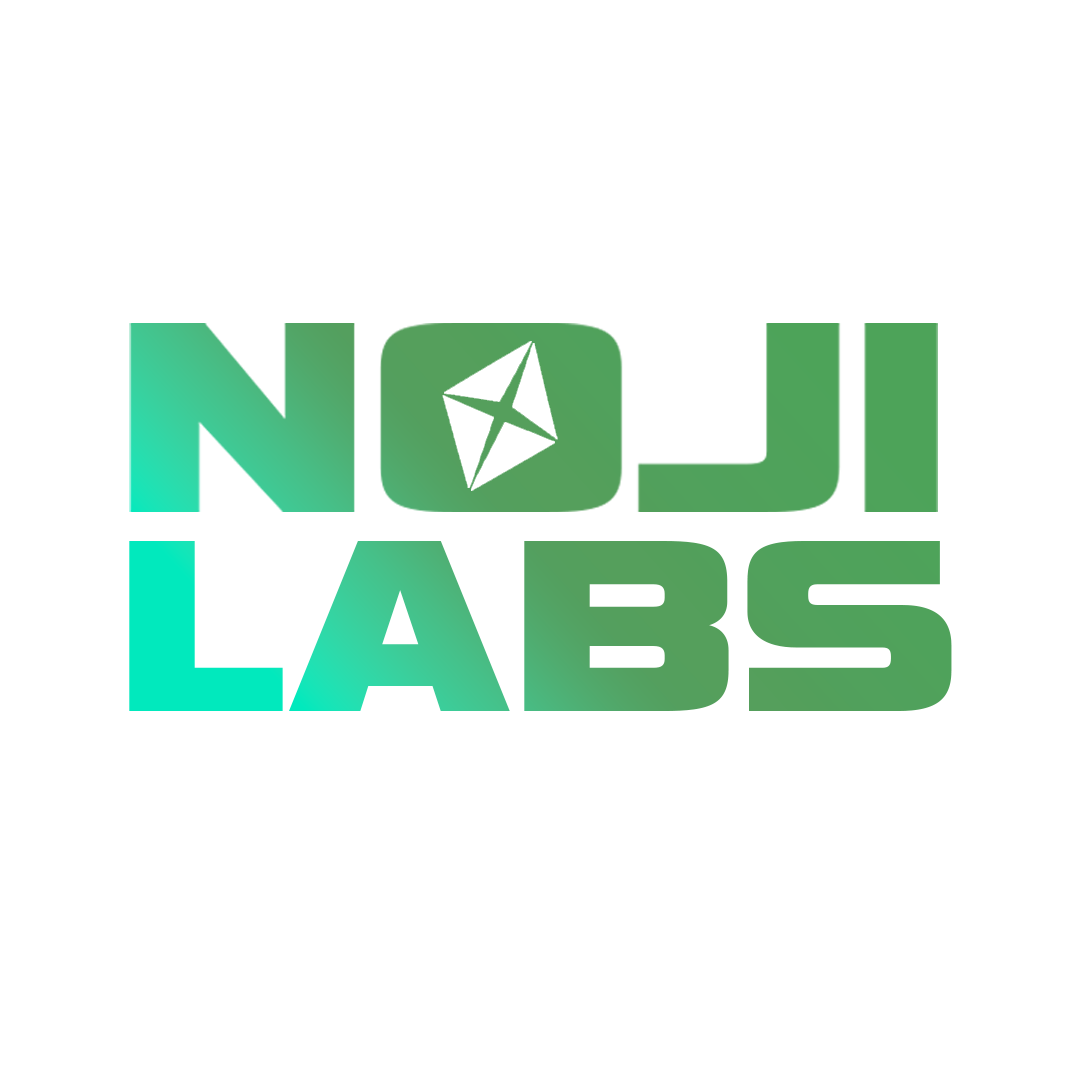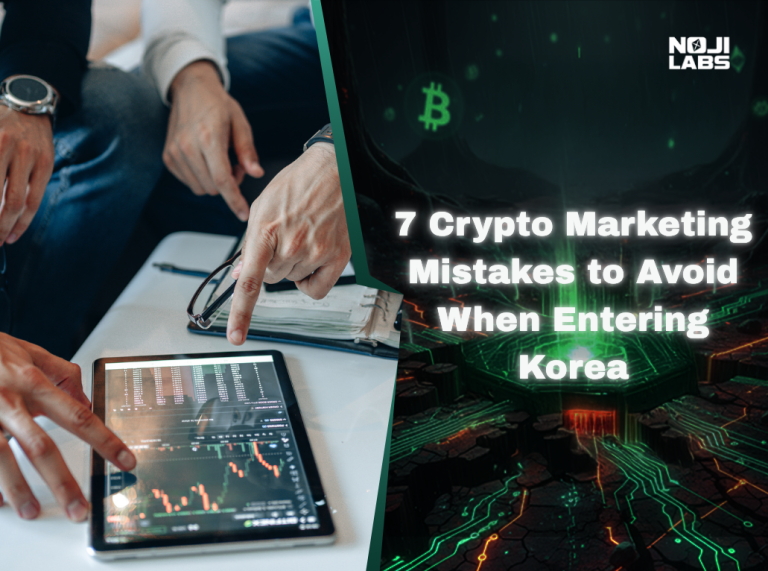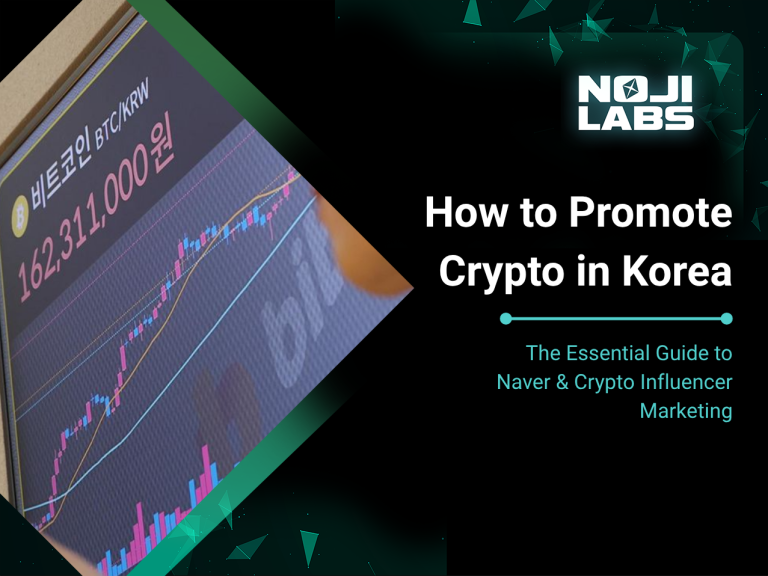
Let’s get one thing straight: crypto advertising in Korea is not for the faint of heart. Forget the “spray ads everywhere and hope for clicks” strategy you might use in the U.S. or Europe, because here, regulators, platforms, and compliance officers are all watching like hawks hopped up on energy drinks. Korea is a global crypto hotspot, sure, but try to run a straightforward campaign and you’ll find yourself smacking face-first into walls of ad restrictions, banned keywords, and Naver’s infamous rejection notices. Sound fun? No. However, here’s the thing: it is survivable if you know how to play the game (and more importantly, if you stop treating Korea like a copy-and-paste of Western markets).
Why Running Crypto Ads in Korea Feels Like Walking a Minefield
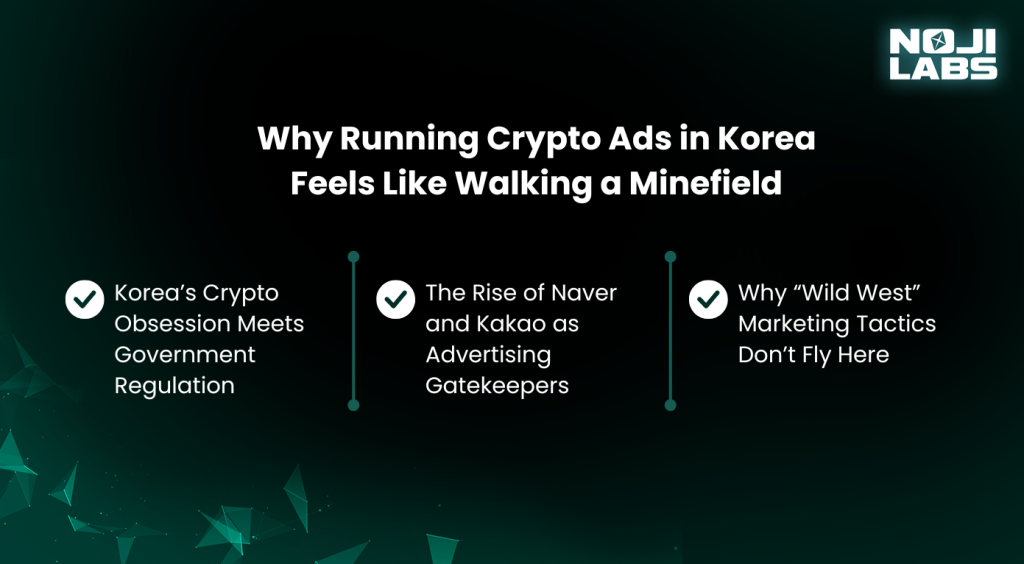
If you think you can stroll into Korea with your global crypto playbook and just “localize the landing page,” you’re in for a rude awakening. This isn’t the Wild West of banner ads and endless PPC budgets. Crypto advertising in Korea is a uniquely hostile and highly regulated environment where platforms like Naver and Kakao set the rules, and those rules are written in microscopic fine print designed to make you sweat.
Korea’s Crypto Obsession Meets Government Regulation
South Korea is one of the most crypto-savvy countries in the world. Retail investors, students, and even retirees all have dabbled in digital assets. But with that popularity came chaos: scams, rug pulls, and too many overhyped projects burning investors. Enter the regulators. Now every exchange, wallet, and ad campaign lives under a microscope. Want to market your token? You’d better bring compliance documents thicker than a K-drama script.
The Rise of Naver and Kakao as Advertising Gatekeepers
Forget Google; if you want visibility in Korea, you’re dealing with Naver crypto ads and Kakao. Problem? They don’t exactly love crypto advertisers. Their policies are vague, their filters are ruthless, and their customer support responses make you wonder if an AI bot is just sending you polite rejections. This means running ads here isn’t just about budget, it’s about survival.
Why “Wild West” Marketing Tactics Don’t Fly Here
Aggressive PPC? Forget it. Pop-ups, hype-laden copy, or anything remotely resembling a “get rich quick” scheme? Insta-banned. In fact, many foreign brands discover too late that their entire campaign is auto-flagged before a single Korean user sees it. Compliance isn’t just a checkbox; it’s the difference between actually running ads and getting blacklisted faster than a scammy ICO.
In short, the Korean market is massive, but the guardrails are high. Treating it like any other territory is a rookie mistake. To win here, you need nuance, patience, and yes, someone who actually knows how to play by (and around) the rules.
The Legal Reality Check — What You Can’t Do
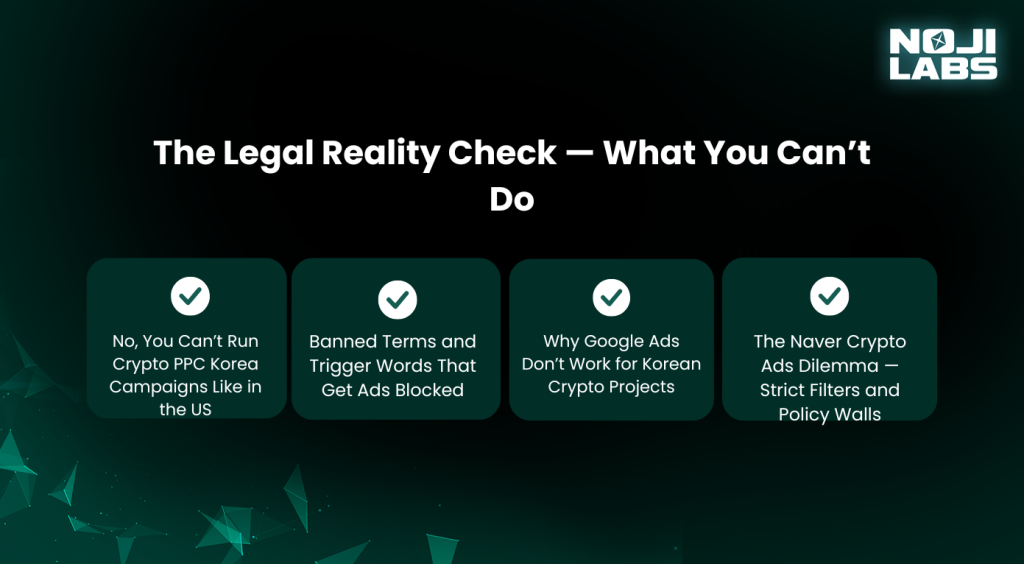
Welcome to the part where dreams go to die. If you could set up a Facebook campaign, add some keywords, and watch the clicks roll in, think again. In Korea, crypto advertising is less about “growth hacking” and more about not tripping every red flag in the regulator’s playbook. Here’s what’s absolutely off-limits (unless you enjoy being ghosted by platforms and blacklisted overnight).
No, You Can’t Run Crypto PPC Korea Campaigns Like in the US
In the States, you might get away with crypto PPC ads that scream “next big token” or “earn passive income.” In Korea? That kind of language is the equivalent of painting a bullseye on your back. Crypto PPC Korea campaigns are under strict scrutiny, and even slightly aggressive calls-to-action can trigger instant rejection.
Banned Terms and Trigger Words That Get Ads Blocked
Say goodbye to buzzwords like “investment,” “profit,” or “guaranteed returns.” Platforms don’t just hate them; they’ve trained their algorithms to choke them out before your ad even finishes review. If your copy even smells like a financial promise, you’re toast.
Why Google Ads Don’t Work for Korean Crypto Projects
Let’s kill this myth right here: Google Ads is not your savior in Korea. Sure, you can technically run them, but good luck reaching anyone. Koreans overwhelmingly use Naver and Kakao. So while you’re burning cash on Google impressions, your actual audience is scrolling elsewhere, laughing at your foreign mistake.
The Naver Crypto Ads Dilemma — Strict Filters and Policy Walls
Ah, Naver crypto ads. The holy grail and the brick wall rolled into one. Naver runs everything through one of the strictest compliance filters in Asia. Translation: if your ad even hints at speculation or token promotion, you’ll get the dreaded rejection notice. And no, appealing won’t save you, unless you enjoy weeks of bureaucratic email ping-pong.
In short? The “can’t do” list is long, annoying, and unforgiving. But understanding these landmines is the first step toward surviving, and actually thriving, in Korea’s crypto ad scene.
The Gray Areas, What You Might Get Away With (If You’re Smart)
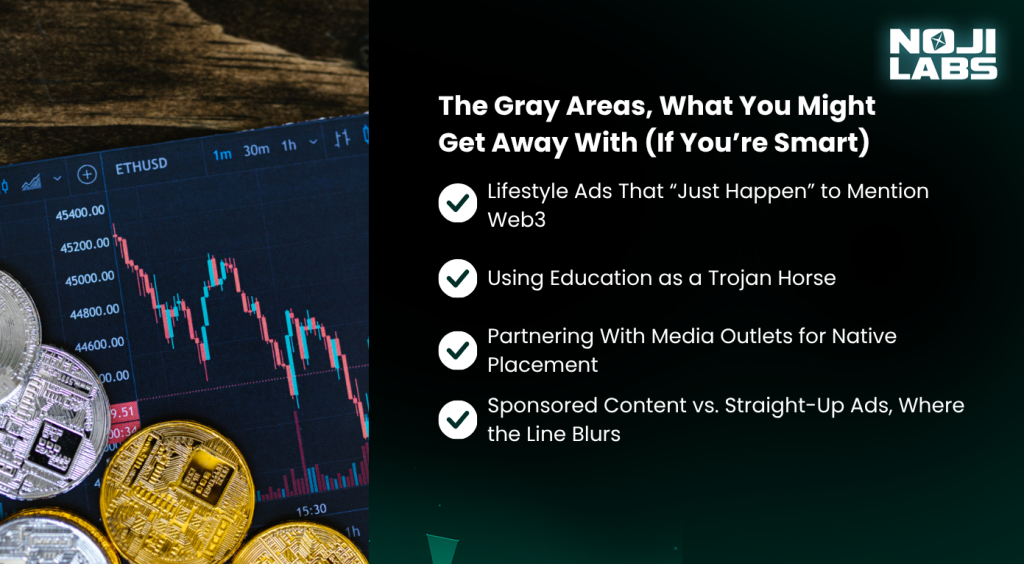
Now for the fun part: the loopholes. Korea’s regulators and platforms may look like brick walls, but if you’re creative (and cautious), you can find cracks in the system. This doesn’t mean running wild, but it does mean using strategies that technically aren’t ads, at least not in the way regulators define them. Welcome to the gray zone.
Lifestyle Ads That “Just Happen” to Mention Web3
Want to get your brand in front of people without screaming “buy our token”? Easy. Wrap it in lifestyle. Show communities, innovation, and culture, and casually mention that your product happens to be powered by Web3. It’s not a crypto ad, it’s an “innovation showcase.” Totally different… right? (wink)
Using Education as a Trojan Horse
Here’s a trick: regulators hate speculation, but they love “financial literacy.” Position your campaign as education-first, with tutorials, workshops, and guides. You’re not selling tokens, you’re “raising awareness about blockchain technology.” It’s safer, smarter, and way more likely to pass the compliance sniff test.
Partnering With Media Outlets for Native Placement
Newsflash: what counts as an “ad” on Naver isn’t the same as a “sponsored article.” If you can’t run display banners, drop some cash on a reputable media partner and land native placements. To readers, it looks like content; to regulators, it’s journalism. Everybody wins.
Sponsored Content vs. Straight-Up Ads, Where the Line Blurs
Here’s where things get messy. Sponsored content can resemble an ad, but because it appears within editorial formats, it’s treated differently. Push too hard and you’ll cross the line. Stay subtle, and you’ll get brand exposure without the compliance nightmare. It’s all about playing chicken with the boundaries, carefully.
Bottom line: The gray zone is where savvy crypto marketers in Korea thrive. It’s not about brute force. It’s about finesse, disguise, and understanding that compliance is less about what you say and more about how you say it.
The Green Light — What You Actually Can Do

Alright, enough with the gray-area gymnastics. Let’s talk about what you can run in Korea without sweating bullets every time you hit “submit” on an ad campaign. Spoiler: the list is shorter than you’d like, but it’s also way more effective if you know how to work it. These are the strategies that pass the compliance filters, keep regulators off your back, and still put your brand in front of the right people.
Paid PR and Sponsored Media Features
PR is your best friend in Korea. Instead of running sketchy banners that get auto-rejected, invest in sponsored articles and media placements on top-tier Korean outlets. They’re trusted, visible, and (bonus!) they can double as content for your SEO strategy. It’s not “advertising,” it’s “coverage.” Regulators love that.
Leveraging Korean Influencers and KOLs Instead of Direct Ads
When you can’t run a crypto PPC Korea campaign, hand the mic to influencers. Crypto-native YouTubers, finance bloggers, even TikTokers can promote your project in ways traditional ads can’t. Just remember: in Korea, influencer marketing must be transparent, so ensure that “sponsored” or 협찬 (hyupchan) tags are clearly visible. Sneaky influencer deals? Regulators eat those for breakfast.
SEO + Content Marketing as Your Long-Term Ad Compliance Strategy
Paid ads are shaky. But SEO in Korea? Untouchable. Invest in long-form content, keyword optimization (hello, “Naver crypto ads”), and educational blog posts. Not only do you dodge ad compliance headaches, but you also build a brand presence that compounds over time. It’s slower than PPC, but it’s also bulletproof.
Display Campaigns with Compliant Language and Positioning
Yes, display ads are possible if you treat your copy like it’s walking on eggshells. Avoid speculative language, financial promises, or anything that even whispers “investment.” Focus instead on brand awareness: tech innovation, partnerships, and community. You’re not selling profit; you’re selling credibility of sale.
The takeaway? The “green light” tactics may feel safe and boring compared to flashy Western-style campaigns. But in Korea, safe = scalable. Play the compliance game right, and you’ll still win eyeballs, without earning yourself a one-way ticket to the blacklist.
Naver Crypto Ads, The Ultimate Headache Explained
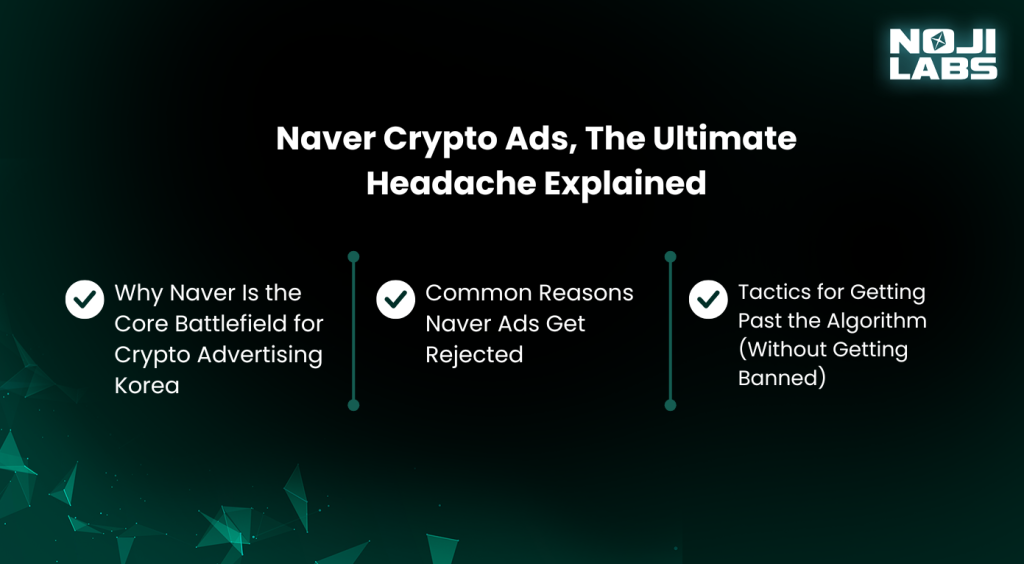
If you want to survive in Korea’s digital jungle, you have to face the beast: Naver. Forget Google; Naver is the search engine in Korea, and if you’re not visible here, you basically don’t exist. The problem? When it comes to crypto advertising Korea, Naver is also your biggest roadblock.
Why Naver Is the Core Battlefield for Crypto Advertising Korea
Koreans don’t “Google” things, they “Naver” them. From search to shopping to news, Naver owns the online ecosystem. Which means if you want brand awareness, you have to get on Naver. For crypto projects, this makes Naver ads the holy grail, the platform where you either win big or crash spectacularly.
Common Reasons Naver Ads Get Rejected
Here’s the fun part (sarcasm fully intended): Naver has some of the most opaque ad policies in the game. Your ad can get rejected for any of the following sins:
- Using words like “investment,” “profit,” or “guaranteed returns.”
- Linking directly to exchanges or token sale pages.
- Even implying speculative behavior (“grow your wealth,” “unlock passive income”).
- Having a landing page that feels too “financial” or not “educational” enough.
Basically, if your ad even flirts with the idea of crypto speculation, it’s dead on arrival.
Tactics for Getting Past the Algorithm (Without Getting Banned)
Here’s where it gets sneaky (but legal). If you want your Naver crypto ads to survive the review, you need to:
- Frame your messaging as educational (“Learn about blockchain,” not “Buy our coin”).
- Use neutral, brand-focused language instead of hype.
- Build landing pages that emphasize community, technology, or innovation over financial returns.
- Partner with approved agencies that know how to speak “Naver compliance” fluently.
Does it feel like threading a needle blindfolded? Absolutely. But that’s the game, and those who play it well can still get visibility where others fail.
In short: Naver is both your best shot at exposure and your most significant migraine. If you don’t respect its filters, your campaign dies before it starts. But if you learn to dance with Naver’s rules (or better, hire someone who already has the moves), it’s still the most powerful advertising channel in Korea’s crypto scene.
The Role of Compliance in Surviving the Korean Market
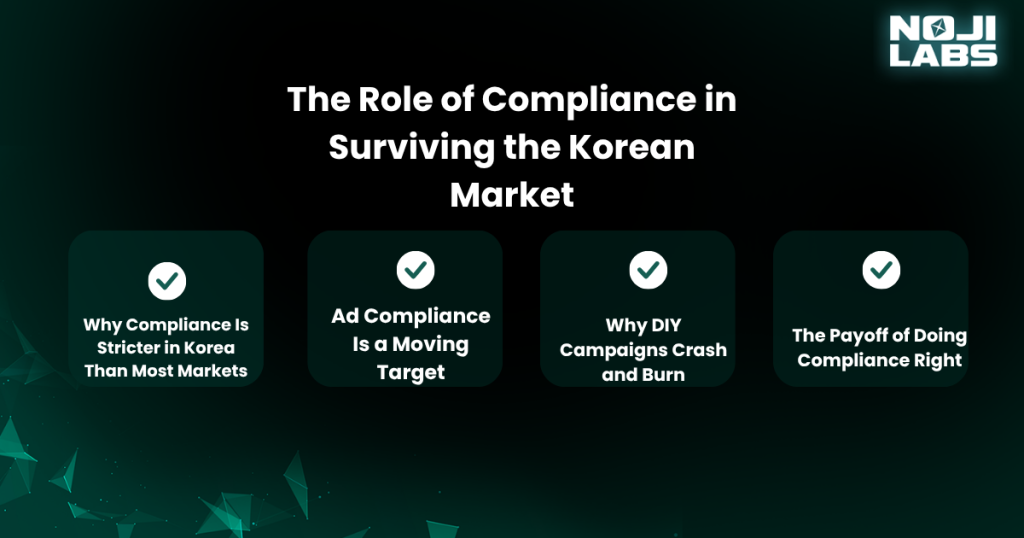
Let’s cut the fluff: in Korea, compliance isn’t a box to check, it’s the entire damn game. You can have the hottest token, the slickest visuals, and a war chest of ad spend, but if you ignore Korea’s ad compliance laws, your campaign is doomed to fail. Worse? You risk regulators putting your brand on the naughty list, and once you’re there, good luck getting back in.
Why Compliance Is Stricter in Korea Than Most Markets
Korea has been burned—hard—by crypto scams. From exchanges collapsing to rug-pull projects that vanished overnight, regulators have seen it all. So now, they enforce crypto advertising rules with an iron fist. The thinking is simple: protect retail investors, eliminate shady players, and require every brand to prove its legitimacy before it touches a single Korean won.
Ad Compliance Is a Moving Target
Here’s the kicker: compliance isn’t static. The rules change, the filters evolve, and what worked last quarter can get you auto-rejected today. Platforms like Naver and Kakao regularly update their crypto ad guidelines, often without clear explanations. This means you can’t just “figure it out once”; you need an ongoing strategy, constant monitoring, and a willingness to pivot quickly.
Why DIY Campaigns Crash and Burn
Foreign brands often believe they can manage their own crypto PPC Korea campaigns. Spoiler: they usually fail. Without deep local knowledge, your ad copy, targeting, and landing pages are basically screaming “non-compliant” in bold letters. Platforms reject them, regulators flag them, and your budget evaporates faster than an altcoin in a bear market.
The Payoff of Doing Compliance Right
Now the upside: if you play by the rules (and get creative within them), compliance becomes your unfair advantage. While your competitors burn cash on failed ads, you’re building credibility with Korean audiences and platforms. And in a market this skeptical, trust is worth way more than clicks.
Compliance in Korea isn’t just survival; it’s the difference between wasting money and building long-term dominance. Ignore it, and you’re toast. Master it, and you’re unstoppable.
Crypto PPC Korea, Is Paid Search Worth the Pain?

Ah, crypto PPC Korea campaigns. The dream of every marketer who thinks, “If I can just bid on the right keywords, I’ll crush it.” Hate to break it to you, but crypto PPC here is like trying to win a boxing match with one hand tied behind your back. Yes, it’s technically possible. Yes, people do it. But is it worth the stress, the compliance hoops, and the endless stream of rejection notices? That’s where things get messy.
The Pros: Why PPC Still Tempts Marketers
- Hyper-Targeted Reach: Search ads put you directly in front of people typing in “crypto wallet Korea” or “Naver crypto ads.” That’s gold, if your ad survives approval.
- Instant Visibility: SEO takes months. PPC gives you clicks tomorrow (assuming you don’t get nuked by Naver’s filters).
- Scalability: Nail a compliant ad strategy once, and you can scale campaigns fast across multiple verticals.
The Cons: Reality Check
- Rejection Hell: Most crypto-related ad submissions are denied automatically. That’s time and money burned.
- Costly Compliance: Even approved PPC campaigns need constant tweaking to stay within shifting guidelines—translation: more budget, more headaches.
- Limited Messaging: Forget hype. Your copy has to be so watered down it feels like you’re advertising bottled water, not blockchain innovation.
The Middle Ground, PPC as Part of a Bigger Strategy
Here’s the truth: PPC in Korea isn’t the hero. It’s the sidekick. You don’t rely on it to carry your campaign; you use it alongside PR, influencer marketing, and SEO. Think of PPC as your scalpel, not your hammer: precise, limited, and only effective in the right hands.
So, is crypto PPC in Korea “worth it”? Only if you’re patient, well-funded, and compliance-obsessed. For everyone else, it’s a money pit. But if you master the rules, PPC can still be the sharp edge of your growth strategy, just don’t expect it to do all the heavy lifting.
Smarter Alternatives to Traditional Crypto Advertising
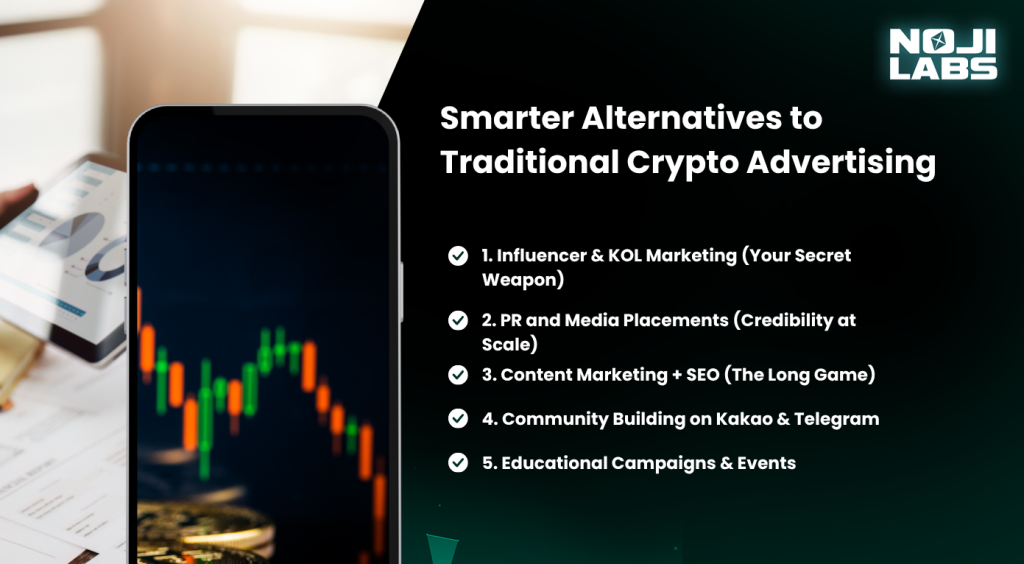
If fighting with crypto PPC Korea campaigns and Naver’s endless rejection machine sounds like a nightmare, it’s because it is. The good news? Paid search isn’t your only weapon. In fact, some of the most effective crypto marketing in Korea doesn’t even look like advertising. It’s stealthier, smarter, and far more aligned with how Koreans actually consume digital content.
1. Influencer & KOL Marketing (Your Secret Weapon)
Koreans trust people more than platforms. Partnering with crypto influencers on YouTube, Twitter (yes, it’s still big here), and even Kakao communities can build credibility fast. These voices bypass ad restrictions while creating authentic buzz. Bonus: They know how to convey compliance-friendly messages without neutering the message.
2. PR and Media Placements (Credibility at Scale)
Instead of wasting your budget on ads that get rejected, invest it in paid PR. Sponsored content in established outlets like Hankyung or Coinness not only gets eyeballs but also delivers the one thing Korean audiences value most: legitimacy. A feature on Naver News? Way more powerful than a banner ad.
3. Content Marketing + SEO (The Long Game)
Want a strategy that regulators can’t kill? Content. Build a Korean-language blog, optimize for Naver crypto ads and other local keywords, and establish yourself as a trusted voice. The beauty of SEO: once your content ranks, it keeps pulling in leads without approval headaches. Slow burn, huge payoff.
4. Community Building on Kakao & Telegram
Forget spray-and-pray ads. In Korea, community is king. Hosting active KakaoTalk and Telegram groups fosters direct engagement, eliminating the need for ad platforms. Think of it as owning the audience instead of renting it through ads.
5. Educational Campaigns & Events
Play the education card. Host webinars, AMAs, or even offline meetups. Frame them as “financial literacy” or “tech innovation” events, and suddenly compliance works in your favor. You’re not advertising; you’re teaching. That subtle pivot makes all the difference.
More innovative alternatives aren’t about dodging compliance; they’re about working with it. While your competitors are wasting months trying to brute-force traditional ads, you’ll be building trust, authority, and community in ways that actually stick.
How Noji Labs Helps You Navigate This Circus
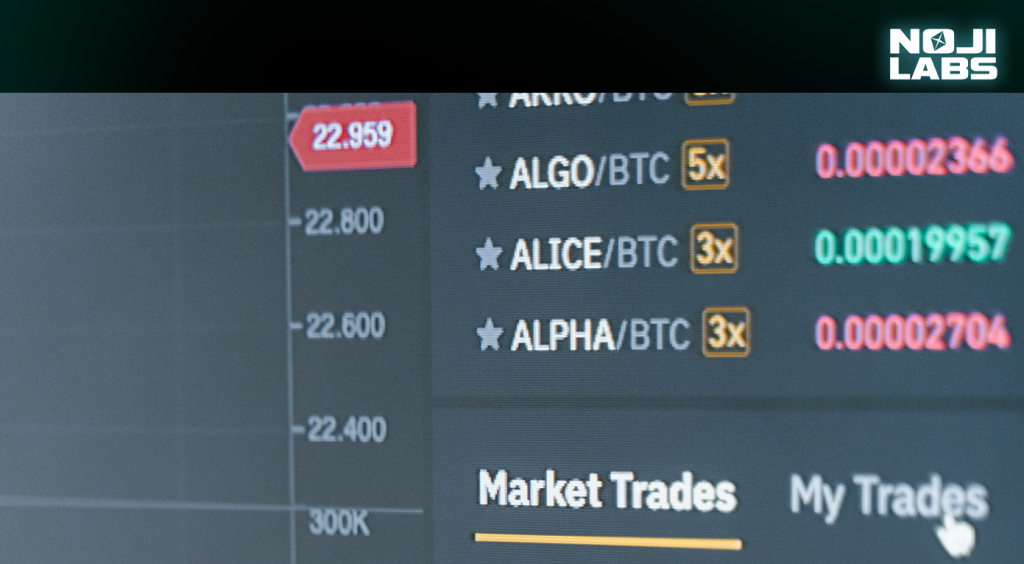
Let’s be blunt: Korea’s crypto advertising scene is not for the faint of heart. Between ironclad regulations, hostile ad platforms, and cultural nuances that can trip up even seasoned marketers, trying to go it alone is asking for disaster. This is where Noji Labs steps in, not as another “agency” that throws generic ad campaigns at the wall, but as a crypto-native operator that actually understands the terrain.
We don’t just translate your message into Korean, we localize your strategy for platforms that matter (Naver, Kakao, YouTube, and yes, even the underground communities that move markets). We know what regulators watch like hawks and what loopholes exist in the gray zones. That means your campaigns aren’t just compliant; they’re strategically designed to bypass blockers without losing impact.
With Noji Labs, you get:
- Compliance without compromise — staying on the right side of the law while still running campaigns that convert.
- Platform-specific mastery — knowing how to adapt your messaging across Korea’s unique ecosystem.
- Insider cultural intel — so your brand doesn’t come off as tone-deaf or “foreign.”
- Battle-tested growth tactics — beyond ads, from influencer partnerships to content marketing designed for Korea’s crypto audience.
Bottom line? While others waste time fighting against Korea’s walls, we show you the side doors, the rooftops, and the hidden alleys that actually get you in. If you’re serious about winning in Korea’s crypto market, Noji Labs is your unfair advantage.
Ready to Play Korea’s Crypto Game the Right Way?

Korea isn’t just another market; it’s a battlefield with rules, landmines, and opportunities hidden in plain sight. Most projects get lost in the noise or crushed by compliance. But with the right partner, you don’t just survive, you win.
Noji Labs is built for precisely this. We’re not a generic marketing shop. We’re a crypto-native strike team that knows how to navigate Korea’s maze of regulations, culture, and platforms while still delivering growth that matters.
Don’t gamble with your entry into Korea. Partner with Noji Labs and turn the chaos into your competitive edge.
FAQs
Crypto PPC Korea is possible, but don’t expect Google Ads or Facebook to roll out the red carpet. Platforms like Naver and Kakao have strict compliance filters, and even then, you’re often limited to brand awareness campaigns rather than conversion-focused ones.
Ah, Naver crypto ads, the ultimate migraine. Naver is the Google of Korea, but they keep crypto ads on a very tight leash. Think ultra-safe branding, no promises of returns, and heavy scrutiny. If you’re sloppy, you’re toast.
Basically, anything that smells like financial advice, guaranteed returns, or reckless hype. Ads must be squeaky-clean, fact-based, and often boring enough to make regulators yawn. That’s why creative strategies matter.

